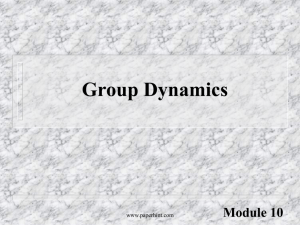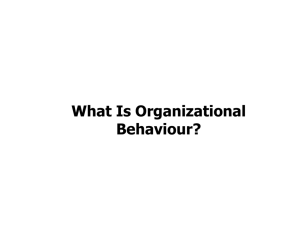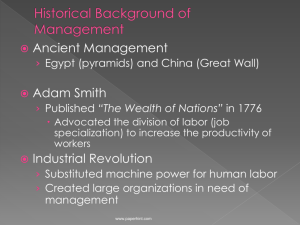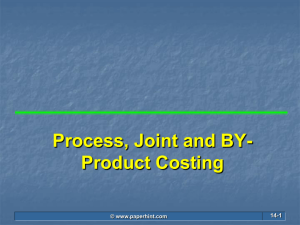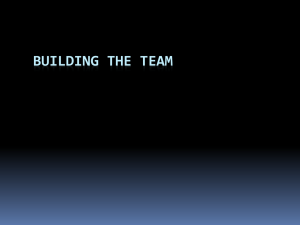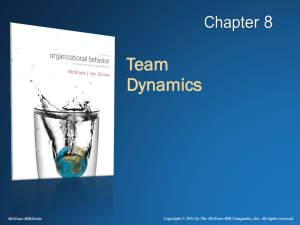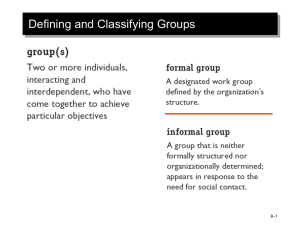ob-08 team dynamics
advertisement
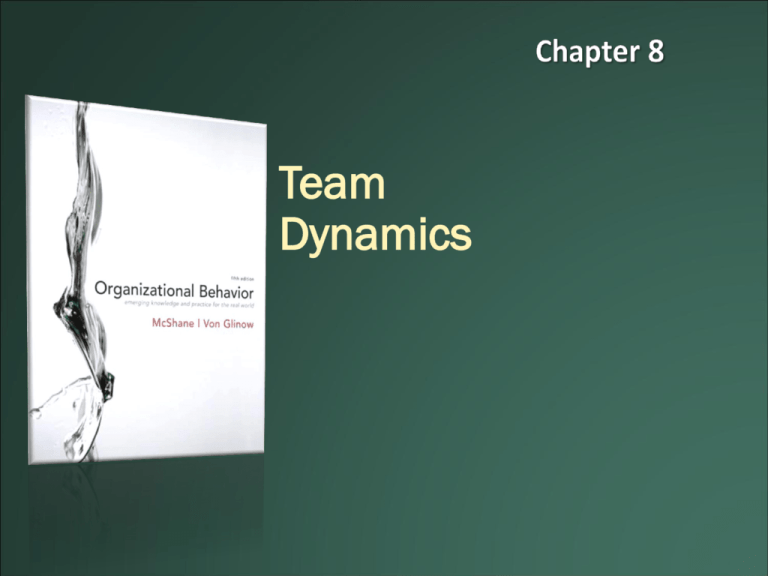
Team Dynamics What are Teams? Groups of two or more people Exist to fulfill a purpose Interdependent -- interact and influence each other Mutually accountable for achieving common goals Perceive themselves as a social entity © PAPERHINT.COM 8-2 Many Types of Teams • Departmental teams • Task force (project) teams • Production/service/ leadership teams • Skunkworks • Self-directed teams • Virtual teams • Advisory teams • Communities of practice © PAPERHINT.COM 8-3 Informal Groups Groups that exist primarily for the benefit of their members Reasons why informal groups exist: 1. Innate drive to bond 2. Social identity -- we define ourselves by group memberships 3. Goal accomplishment 4. Emotional support © PAPERHINT.COM 8-4 Advantages and Disadvantages of Teams Advantages • Make better decisions, products/services • Better information sharing • Higher employee motivation/engagement - Fulfills drive to bond - Closer scrutiny by team members - Team members are benchmarks of comparison Disadvantages • Individuals better/faster on some tasks • Process losses - cost of developing and maintaining teams • Social loafing © PAPERHINT.COM 8-5 How to Minimize Social Loafing Make individual performance more visible • Form smaller teams • Specialize tasks • Measure individual performance Increase employee motivation • Increase job enrichment • Select motivated employees © PAPERHINT.COM 8-6 Team Effectiveness Model Team Design •Task characteristics Team Effectiveness •Team size Organizational •Team composition • Satisfy member needs and Team Environment • Accomplish tasks Team Processes • Maintain team survival • Team development • Team norms • Team cohesiveness • Team trust © PAPERHINT.COM 8-7 Organization/Team Environment Reward systems Communication systems Organizational structure Organizational leadership Physical space © PAPERHINT.COM 8-8 Team’s Task Characteristics Teams work better when tasks are clear, easy to implement • learn roles faster, easier to become cohesive • ill-defined tasks require members with diverse backgrounds and more time to coordinate Teams preferred with higher task interdependence • Extent that employees need to share materials, information, or expertise to perform their jobs. © PAPERHINT.COM 8-9 Levels of Task Interdependence High A Reciprocal B Sequential A C B C Resource Pooled Low A B C © PAPERHINT.COM 8-10 Team Size Smaller teams are better because: • need less time to coordinate roles and resolve differences • require less time to develop more member involvement, thus higher commitment But team must be large enough to accomplish task © PAPERHINT.COM 8-11 Shell Looks for Team Players Shell holds the 5-day Gourami Business Challenge in Europe, North America, and Asia to observe how well the university students work in teams. One of the greatest challenges is for students from different cultures and educational specializations to work together. © PAPERHINT.COM 8-12 Team Composition Effective team members must be willing and able to work on the team Effective team members possess specific competencies (5 C’s) © PAPERHINT.COM 8-13 Five C’s of Team Member Competencies © PAPERHINT.COM 8-14 Team Composition: Diversity Team members have with diverse knowledge, skills, perspectives, values, etc. Advantages • better for creatively solving complex problems • broader knowledge base • better representation of team’s constituents Disadvantages • take longer to become a high-performing team • more susceptible to “faultlines” • increased risk of dysfunctional conflict © PAPERHINT.COM 8-15 Stages of Team Development Performing Norming Storming Forming Existing teams might regress back to an earlier stage of development Adjourning © PAPERHINT.COM 8-16 Team Development as Membership and Competence Two central processes in team development 1. Team membership formation • Transition from “them” to “us” • Team becomes part of person’s social identity 2. Team competence development • Forming routines with others • Forming shared mental models © PAPERHINT.COM 8-17 Team Roles A set of behaviors that people are expected to perform Some formally assigned; others informally Informal role assignment occurs during team development and is related to personal characteristics © PAPERHINT.COM 8-18 Team Building Formal activities intended to improve the team’s development and functioning Types of Team Building • Clarify team’s performance goals • Improve team’s problem-solving skills • Improve role definitions • Improve relations © PAPERHINT.COM 8-19 Team Norms Informal rules and shared expectations team establishes to regulate member behaviors Norms develop through: • Initial team experiences • Critical events in team’s history • Experience/values members bring to the team © PAPERHINT.COM 8-20 Preventing/Changing Dysfunctional Team Norms State desired norms when forming teams Select members with preferred values Discuss counter-productive norms Reward behaviors representing desired norms Disband teams with dysfunctional norms © PAPERHINT.COM 8-21 Team Cohesion The degree of attraction people feel toward the team and their motivation to remain members Both cognitive and emotional process Related to the team member’s social identity © PAPERHINT.COM 8-22 Influences on Team Cohesion Member similarity • Similarity-attraction effect • Some forms of diversity have less effect Team size • Smaller teams tend to be more cohesive Member interaction • Regular interaction increases cohesion • Calls for tasks with high interdependence © PAPERHINT.COM 8-23 Influences on Team Cohesion (con’t) Somewhat difficult entry Team success External challenges • Team eliteness increases cohesion • But lower cohesion with severe initiation • Successful teams fulfillmember needs • Success increases social identity with team • Challenges increase cohesion when not overwhelming © PAPERHINT.COM 8-24 Team Cohesion Outcomes 1. Motivated to remain members 2. Willing to share information 3. Strong interpersonal bonds 4. Resolve conflict effectively 5. Better interpersonal relationships © PAPERHINT.COM 8-25 Team Cohesion and Performance Team Norms Support Company Goals Team Norms Oppose Company Goals Moderately high task performance High task performance Moderately low task performance Low task performance Low Team Cohesiveness High Team Cohesiveness © PAPERHINT.COM 8-26 Trust Defined Positive expectations one person has of another person in situations involving risk © PAPERHINT.COM 8-27 Three Levels of Trust High Identification-based Trust Knowledge-based Trust Calculus-based Trust Low © PAPERHINT.COM 8-28 Self-Directed Teams Defined Cross-functional work groups organized around work processes, that complete an entire piece of work requiring several interdependent tasks, and that have substantial autonomy over the execution of those tasks. © PAPERHINT.COM 8-29 Self-Directed Team Success Factors Responsible for entire work process High interdependence within the team Low interdependence with other teams Autonomy to organize and coordinate work Technology supports team communication/coordination © PAPERHINT.COM 8-30 Virtual Teams Teams whose members operate across space, time, and organizational boundaries and are linked through information technologies to achieve organizational tasks • Increasingly possible because of: - Information technologies - Knowledge-based work • Increasingly necessary because of: - Organizational learning - Globalization © PAPERHINT.COM 8-31 Virtual Team Success Factors Member characteristics • Technology savvy • Self-leadership skills • Emotional intelligence Flexible use of communication technologies Opportunities to meet face-to-face © PAPERHINT.COM 8-32 Team Decision Making Constraints Time constraints • Time to organize/coordinate • Production blocking Evaluation apprehension • Belief that others are silently evaluating you Peer pressure to conform • Suppressing opinions that oppose team norms Groupthink • Tendency in highly cohesive teams to value consensus at the price of decision quality • Concept losing favor -- consider more specific features © PAPERHINT.COM 8-33 General Guidelines for Team Decisions Team norms should encourage critical thinking Sufficient team diversity Ensure neither leader nor any member dominates Maintain optimal team size Introduce effective team structures © PAPERHINT.COM 8-34 Constructive Conflict Courtesy of Johnson Space Center/NASA People focus their discussion on the issue while maintaining respectfulness for others having different points of view. Problem: constructive conflict easily slides into personal attacks © PAPERHINT.COM 8-35 Rules of Brainstorming 1. Speak freely 2. Don’t criticize 3. Provide as many ideas as possible 4. Build on others’ ideas © PAPERHINT.COM 8-36 Evaluating Brainstorming Strengths • Produces more creative ideas • Less evaluation apprehension when team supports a learning orientation • Strengthens decision acceptance and team cohesiveness • Sharing positive emotions encourages creativity Weaknesses • Production blocking still exists • Evaluation apprehension exists in many groups © PAPERHINT.COM 8-37 Electronic Brainstorming Relies on networked computers to submit and share creative ideas Strengths -- more creative ideas, minimal production blocking, evaluation apprehension, or conformity problems Limitations -- too structured and technologybound © PAPERHINT.COM 8-38 Nominal Group Technique Describe problem Individual Activity Team Activity Individual Activity Write down possible solutions Possible solutions described to others Vote on solutions presented © PAPERHINT.COM 8-39

